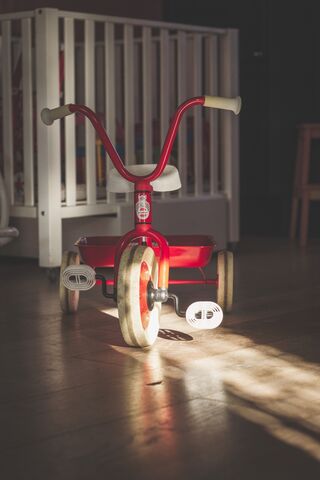Attachment
How to Release Attachment to Sentimental Things
Letting go of the past to make room for the future.
Posted July 7, 2021 Reviewed by Gary Drevitch
Key points
- Simplify life by designating a set space to hold things and practice one-in-and-one-out once it's filled.
- To let go of sentimental items, invite relevant people to help you review and release the items together.
- When letting go of sentimental items, thank the items, so that gratitude replaces fear or sadness.

I looked at the pile of eight boxes of toys and wondered, “How will I let some of this go?” My youngest is now 18 and off to college. Many of the boxes had not been opened in 10 years or more, having spent that time on shelves and in garage rafters. They were now the next target of my continual effort to simplify and downsize my life. With every box I opened, a flood of memories came to me of happy kids playing and of being a younger woman, mothering day and night. I knew giving away the toys would be hard for me, though it might just as well have been a box of pictures, or a doll collection cherished by a grandmother. The basic challenge is that I am sentimental, and giving away pieces of the past is not easy for me. To prepare, I read three books to build my confidence that led me to a three-step process.
Confine the space
My first step was to designate one shelf in the garage and commit to keeping no more than would fit on that shelf. To fit everything on that shelf, two-thirds of what I owned would have to go. This designation was very helpful in that it assured me I would keep the most important things, and also gave me something by which to measure the amount that I would keep. Dana White, in her 2018 book Decluttering at the Speed of Life, refers to this as a “container approach,” but I came to the same approach for myself a couple of years earlier; if I limit a collection of things, such as books, to two bookcases, then when I run out of room I have to choose something to go if I want to add more. “One in; one out” is my mantra. Confining my possessions to a set space is a natural way to limit how much I have.

Bring in social support
The second step for me was to get some social support for the effort to release things, as recommended in Peter Walsh’s 2019 book, Let it Go. In my case, I asked my kids (now not kids) to gather at my house. Together we went through the boxes and they let me know if there was anything they definitely wanted to keep. This was the fun part. I wanted us all in one spot so we could remember and let go together. This mattered to me. I wanted a gathered farewell for the favored objects of their childhood. I also wanted to know that I wasn’t giving away anything that really mattered to them. Not too surprisingly, I was far more attached to the toys than my 18-, 23-, and 26-year-old children were. “Mom, seriously, we had fun with all of this, but why keep it now?” I sheepishly answered, “I saved things ‘just in case’ small kids came to visit or perhaps for a day where there are grandchildren, so they can play with your old things.” The looks on their faces assured me that I was keeping things more for me than them at this point.
Practice gratitude
The third step is really important. I followed Marie Kondo's advice of thanking the things that were going to be given away and then putting them in the donation box. I did this mentally, as a type of prayer. Gratitude replaced the grief. I left the pile with a deep peace and no sadness. I thought I was home free.

The struggle to let it go revisited
A week passed until the Veterans’ thrift shop came to pick up the toys. One item, which I had not originally had in the pile, was a small tricycle. My sweetheart, being ever so helpful, grabbed it and brought it to the pile with a jovial, “How about this too?” I looked at it, tears swelling in my eyes — did I mention that I am sentimental? — and said, "Not yet.” I took it into the garage, knowing that at some point I would need to release it too. As I set it down in the garage, which remained full of things yet to be organized or given away, I had a talk with the tricycle. I thanked it for all the joy it gave my kids, for all the fun it had brought to our lives, for the memories I had of little ones trying to figure out pedals, and the time it was used by adolescents to swoop up and down a skateboard ramp. By the time I was done thanking it, I knew I needed to turn around and take it back to the pile, to the amusement of my Sweetheart. I was still a little sad, but my emotional grip had loosened.
The pile was put out around 7 am and about two hours later, a neighbor with his energizing and happy two-year-old son came walking by. We started to talk, and it flashed in my mind that some of the toys might be of interest to the boy. Nothing captured his interest as much as the tricycle. Needless to say, the tricycle never made it to the thrift shop.
Thoughts on being a sentimental person
I tell this story because so many times in my life I have found that once I release something to which I am clinging, the universe seems to conspire to make all pieces fall into place. I had been saving that tricycle to give to a child I liked and knew. The moment I was willing to give it away to a stranger, the right child came along to claim it. Letting go of things is so much easier when we know they will be appreciated by a new owner, but there are times when we have to let go and release our attachment first. I am not sure if we sentimental types can give things away without some deep conversations with the things we cherish and with ourselves.
References
Kondo, M. (2014). The Life-Changing Magic of Tidying Up: The Japanese Art of Decluttering and Organizing. New York: Ten Speed Press.
Walsh, Peter (2019). Let it go: Downsizing your way to a richer happier life. New York: Rodale Books.
White, D. K. (2018). Decluttering at the speed of life: Winning your never-ending battle with stuff. Nashville, TN: Thomas Nelson.


